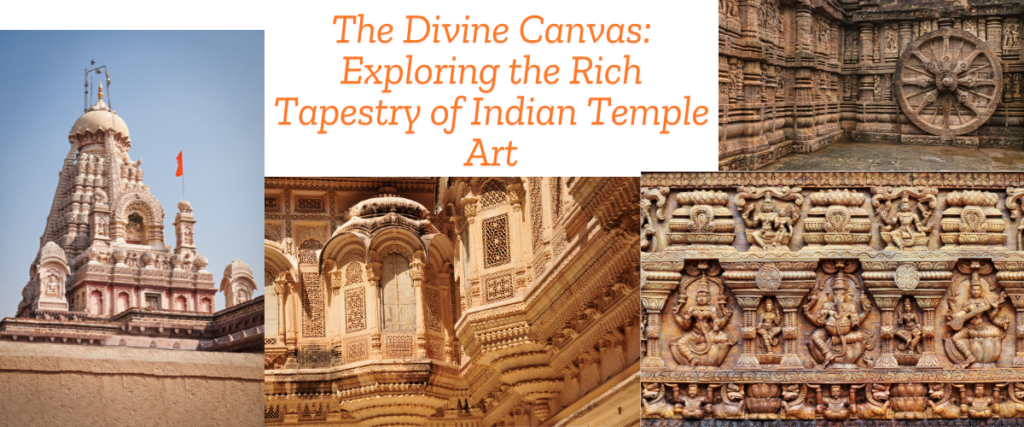India, a land of vibrant cultures and profound spirituality, has long been considered a cradle of artistic expression. Perhaps, due to the unique mix of cultures and deep spiritualism, it has almost always been regarded as a land of art. One of its most beautiful and eternal legacies is the art of building temples and witnessing the Hindus’ ancient grandeur, spirituality, and architectural prowess. Indian temple art — that is what we’re talking about : a form of art that is not only an aesthetic expression but a visualised complex symbolic language that tells you tales of divine beings, semi-divine beings and philosophical beliefs depicted in wood, stone and metal.
A Journey Through Time: Evolution and Styles
The evolution of Indian temple art can be traced back to the Maurya period (3rd century BCE), when the most primitive stupas, the earliest type of Buddhist architecture, were built. But it was the Gupta period (4th–6th century CE) that was a golden age, bringing a new sophistication to temple structures and a richness to the intricate sculptural art. Regional variations began to develop over the centuries during which people inhabited the area, creating different architectural styles with certain unique features.
- Nagara Style (North India): Characterised by its curvilinear shikhara (spire), the Nagara style is exemplified by temples like the Kandariya Mahadeva Temple in Khajuraho and the Sun Temple in Konark. These temples often feature elaborate carvings of deities, celestial beings, and erotic sculptures.
- Dravida Style (South India): Distinguished by its towering gopurams (gateway towers), the Dravida style is prominently seen in temples like the Brihadeeswarar Temple in Thanjavur and the Meenakshi Amman Temple in Madurai. These temples are known for their massive enclosures, intricate mandapas (halls), and pyramidal vimanas (towers).
- Vesara Style (Deccan Region): A hybrid of the Nagara and Dravida styles, the Vesara style combines elements of both, resulting in temples with unique architectural features. The Hoysaleswara Temple in Halebidu is a prime example of this style, renowned for its intricate star-shaped platforms and exquisitely carved sculptures.
Sculptural Narratives: Telling Stories in Stone
Sculpture is an integral part of Indian temple art, serving as a visual narrative of religious and mythological tales. The sculptures are not just for aesthetics or merely decorative; they are suffused with symbolic meaning, conveying complex philosophical and spiritual concepts.
- Deities and Divine Forms: Temples are adorned with sculptures of various Hindu deities, each with their own iconography and symbolism. Shiva, Vishnu, Devi, Ganesha, and Surya are among the most frequently depicted deities, each representing different aspects of the divine.
- Apsaras and Mithunas: Celestial nymphs (apsaras) and loving couples (mithunas) are common motifs, symbolising beauty, fertility, and auspiciousness. They often adorn the walls and pillars of temples, adding a touch of sensuality and grace.
- Mythological Scenes: Sculptures often depict scenes from Hindu epics like the Ramayana and Mahabharata and stories from the Puranas. These narratives educate and inspire devotees, conveying moral and ethical lessons.
- Animal and Floral Motifs: Animal and floral motifs are also prevalent, symbolising natural forces and auspicious qualities. Elephants, lions, horses, and various flowers and plants are frequently depicted, adding a sense of vitality and harmony to the temple architecture.
Architectural Marvels: Beyond Aesthetics
Indian temples are not just works of art; they are architectural marvels that demonstrate the advanced engineering skills of ancient Indian builders. The temples are often built following complex fundamental geometric principles or astronomical calculations, reflecting their in-depth knowledge of the cosmos.
- Vastu Shastra: The design and construction of temples are steered by the principles of Vastu Shastra, an ancient Indian science of architecture that emphasises harmony between human dwellings and the natural environment.
- Astronomical Alignments: Many temples are aligned with cardinal directions and celestial events, such as solstices and equinoxes. This alignment reflects the importance of astronomy in Indian culture and the belief in the interconnectedness of the cosmos.
- Engineering Feats: The construction of massive stone temples, some of which are carved out of single rocks, is a testament to the engineering prowess of ancient Indian builders. The preciseness, accuracy and scale of these structures are truly awe-inspiring.
Beyond Hinduism: Buddhist and Jain Temples
While Hindu temples are the most prominent, India is also home to magnificent Buddhist and Jain temples, each with its own unique architectural and artistic traditions.
- Buddhist Stupas and Chaityas: Buddhist architecture is characterised by stupas (domed structures containing relics) and chaityas (prayer halls). The Sanchi Stupa and the Ajanta Caves are prime examples of Buddhist architecture, featuring intricate carvings and paintings.
- Jain Temples: Jain temples are well-known for their elegant, intricate carvings and white marble construction. The Dilwara Temples in Mount Abu and the Ranakpur Jain Temple are renowned for their exquisite craftsmanship and architectural beauty.
The Enduring Legacy: Preservation and Appreciation
Indian temple art is a living tradition that continues to inspire and captivate people around the world. The appreciation and preservation of this rich cultural heritage are essential for future generations.
- Conservation Efforts: Government agencies and various organisations are working to conserve and restore ancient temples, ensuring their longevity and preserving their artistic and historical significance.
- Cultural Tourism: Temples are popular tourist destinations, attracting visitors from around the world who admire their architectural beauty and learn about Indian culture and religion.
- Artistic Inspiration: Indian temple art continues to inspire contemporary artists and architects, providing motivation for new forms of artistic expression.
Conclusion
The intricate and awe-inspiring world of Indian temple art reverberates with the echoes of the country’s rich cultural heritage, artistic excellence, and spiritual depth. Whether it is the soaring gopurams of South India, the elaborate silver doors, or the intricate carvings of North India, they all relay a message of some sort, representing the ethos of Indian philosophy and bhakti. The protection and promotion of this monumental heritage is essential to make certain that future generations continue to marvel at the divine canvas of Indian temple art.
Disclaimer
This blog entry gives a broad idea about Indian temple art. This information is based on publicly available data and should not be construed as a complete, conclusive report. The interpretation of art and religious symbolism can vary, and individual perspectives may differ. While every effort has been made to ensure accuracy, the author is not responsible for any errors or omissions. Readers are encouraged to conduct further research and confer with experts for a more comprehensive understanding of the subject.


